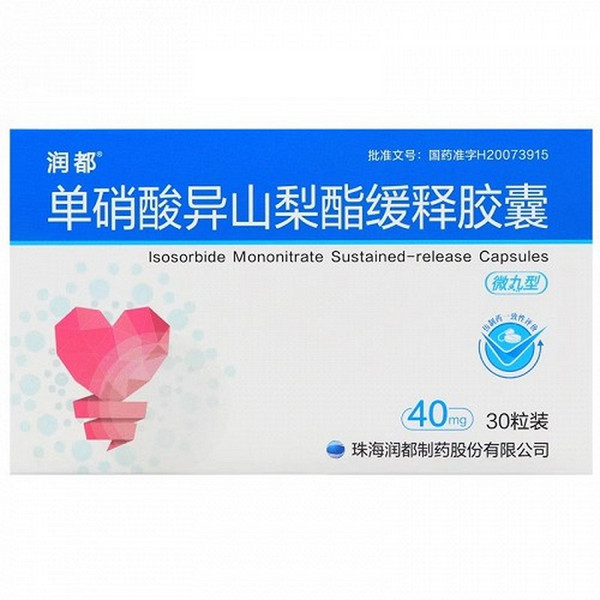Product Overview
[Drug Name]
Generic Name: Isosorbide Mononitrate Sustained-Release Capsules
Trade Name: Rundu Isosorbide Mononitrate Sustained-Release Capsules 40mg x 30s
[Main Ingredient]
Isosorbide Mononitrate
[Indications/Main Functions]
1. Long-term treatment of coronary heart disease.
2. Long-term treatment and prevention of angina pectoris (including post-myocardial infarction).
3. Combination with digitalis and/or diuretics for the treatment of chronic congestive heart failure.
[Specifications]
40mg x 30s
[Dosage and Administration]
Oral. Take one tablet once daily. Swallow whole (do not chew) with an appropriate amount of warm water. For patients with unstable circulation, the first dose may cause vascular collapse symptoms and nitrate headache. A non-long-acting formulation can be taken at the beginning of treatment, half a tablet in the morning and half in the evening, to significantly reduce these symptoms.
[Adverse Reactions]
The most common adverse reaction with this product is headache (>10% of patients), which gradually subsides with time and continued use. Orthostatic hypotension and/or mild headache are common with initial administration or when the dose is increased. These symptoms may be associated with dizziness, drowsiness, reflex tachycardia, and fatigue. Rarely (in <1% of patients), nausea, vomiting, flushing, and allergic skin reactions (e.g., erythema) may occur, sometimes severely. Exfoliative dermatitis has occurred in isolated cases. Severe hypotension, including nausea, vomiting, restlessness, pallor, and sweating, has been reported with the use of organic nitrates. Collapse (often accompanied by bradycardia and syncope) has been reported rarely. Severe hypotension leading to exacerbation of angina symptoms has been reported rarely. There have been a few reports of heartburn caused by nitrate-induced sphincter relaxation. Treatment with this medication may result in transient hypoxemia due to increased blood supply to poorly ventilated alveoli (forming a pulmonary "bypass"). This can lead to myocardial hypoxia, particularly in patients with coronary artery disease.








